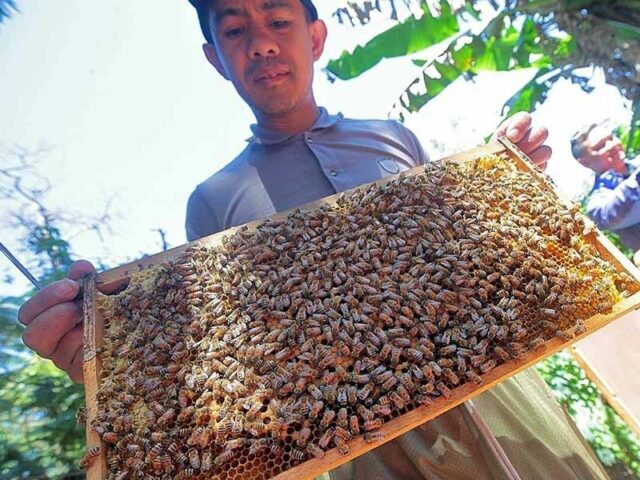By Adrian H. Halili, Reporter
MINERS are expected to perform well in 2024 due to increased demand for transition minerals used by the renewable energy industry, mining officials said.
“The government is pushing for local mineral processing of energy transition metals such as nickel and copper and the Philippine metallic mining industry would like to participate and take advantage of opportunities presented by this development,” Michael T. Toledo, chairman of the Chamber of Mines of the Philippines (CoMP), said in a Viber message.
Environment Secretary Maria Antonia Yulo-Loyzaga has said that the Department of Environment and Natural Resources (DENR) will encourage exploration for critical minerals this year, with the Mines and Geosciences Bureau (MGB) instructed to gear up for enabling projects undertaken with foreign mining partners.
Nickel, cobalt, and copper are deemed essential for the production of electric vehicles (EVs), the large-scale batteries which power them, and also wind and solar farms.
“A lot still needs to be done but we believe the signposts show we are on a course that is likely to result in success,” Mr. Toledo added.
The Philippine Nickel Industry Association (PNIA) said the industry is pushing for the government to fast-track the approval of mining permits by establishing a “one-stop shop” application process.
According to the PNIA, the streamlining of approvals will attract more investment in mining.
About 470 applications are currently awaiting approval. They are proposing to explore for copper, chromite, nickel, and cobalt, according to the MGB.
Phase 1 of the MGB’s priority list consists of metallic mines, with about 12 projects expected to start operations in the next six months.
“If realized, this (encourages) upbeat expectations for the production and export of more of these goods, given the high level of global demand,” the MGB said in its metallic production report.
These operations are a magnetite sand (Iron) site in Region 2, nickel laterite in Region 3, gold in Region 5, four nickel, copper and gold sites in Region 11, and five nickel, copper and gold sites in Caraga.
CoMP said metals prices would mainly depend on the recovery of China’s economy, a major user of Philippine minerals.
“Traders are cautious of the incoming year, considering the weaker Chinese economy and significantly cheaper nickel pig iron (NPI) from Indonesia,” Mr. Toledo said.
He added that the mining industry expects Indonesia to keep up its NPI output.
NPI is low-grade ferronickel, which serves as a cheaper alternative to higher-grade nickel used in stainless steel production.
“We don’t know when China’s economy will improve. Most developed countries are challenged at this time,” he said.
PNIA has said that nickel production this year will likely remain flat due to the limited capacity in ore-supplying regions.
The MGB said however that due to domestic nickel supply concerns in Indonesia, Chinese demand for nickel ore from the Philippines will rise.
It added that Indonesia has become a new export market for nickel ore. The Philippines has exported about 102,100.72 dry metric tons of nickel ore to Indonesia amounting to P171.37 million during the nine months to September.
Mr. Toledo said that the industry is optimistic that the Philippines can service global copper demand.
However, he said that in the absence of new copper mining operations in the next five years, “there could be a supply deficit that would drive prices upward.”
“In the next few years, we believe the Philippine copper sector can keep up with the demand for this metal as an input for renewable energy technologies,” he said.
“As the global demand for critical minerals for the energy transition intensifies, however, there are concerns on whether copper from Philippine mines can keep up,” he added.
Rizal Commercial Banking Corp. Chief Economist Michael L. Ricafort said the demand for raw materials from the renewable energy industry is expected to grow in the coming years.
“There will still be a large shift towards renewable and towards electric vehicles for the coming years amid the need for more sustainable source of energy and the need to reduce carbon emissions,” Mr. Ricafort said in a Viber message.
Mr. Ricafort added that a decline in global interest rates could also drive more investment towards minerals.
“Lower borrowing costs will encourage more investment and business activity, as well as the demand for minerals,” he said.
The Federal Reserve maintained its target rate in the 5.25%-5.5% range for a third straight meeting on Dec. 12-13.
The Bangko Sentral ng Pilipinas kept its key borrowing rate unchanged at 6.5% during its Dec. 15 meeting.
Regina Capital Development Corp. Head of Sales Luis A. Limlingan said metal prices will largely be influenced by the strength of the Chinese economy and its adoption of EVs.
“The Philippines will be able to take advantage, should responsible mining practices be put in place to allow further export of our precious minerals,” Mr. Limlingan said in a Viber message.
Prices for nickel ore declined to $10.39 per pound from $11.97 per pound the previous year.
“For nickel, attributing factors to growth during the period are the improvement of nickel ore prices and better loading conditions on account of good weather, particularly in the southern part of the country,” Mr. Toledo said.
The price of gold increased to $1,932.07 per troy ounce, while copper prices fell to $3.9 per pound from $4.12 a year earlier. Silver prices rose 7.32% to $23.55 per troy ounce.
“The low copper prices were offset also by good weather, which resulted in less production interruptions, as well as by the strong dollar-to-peso exchange rate,” he added.












